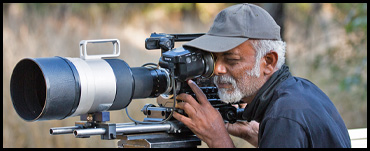Buy from 1,00,000+ Videos and curated by us.
From National History Unit India
Cinematographer, Director & Producer
Nalla is a freelance cinematographer, director and producer since 1987. In a twenty year long career he’s had the opportunity to shoot feature films, documentaries, news, corporate films and TV shows.

Nalla is a freelance cinematographer, director and producer since 1987. In a twenty year long career he’s had the opportunity to shoot feature films, documentaries, news, corporate films and TV shows.
and international acclaim.
Nalla has dedicated the last five years of his life filming in India’s forests. His passion for the Royal Bengal Tiger has translated into two international documentaries which he has produced, filmed and directed. His first film, ‘Tiger Queen’ highlights the power struggle in a family of tigers and was broadcast on National Geographic Wild and Animal Planet.
Four times national award winner S.nallamuthu introduces the wildest with humane touch.
South Indian Film chamber of commerce Reg No: 21205
Tamil Film Producer Council No : 2140
 LinkedIn
LinkedIn

Best Environment Film For The World’s Most Famous Tiger

Best Exploration/ Adventure Film For Tiger Dynasty

Best Non-Feature Film Cinematography For Tiger Dynasty

Best Exploration/ Adventure For Life Force - Western Ghats

Member

Member









They are the fine indicator of a healthy functional ecosystem; they are beautiful there is a bit of a bias there; it sa charismatic species why you dint want to save it, to begin with. If you look at the culture, religion and folk tale, tigers are species that occur every wher, they are the symbol of reverence of our fascination and our fondness in nature. They are the ambassador; they represent the entire ecosystems, it is great to have sambar deer asan ambassador. Why not, they are; it does not mean that any species is less important. It is about how you look at it.Perception.
Apex predator defines the ideal it defines the everything the umbrella is covering, things go wrong with ant thing in the ecosystem; it affects the tigers. Ultimately everything will start affecting. Surely one of the biggest teaching is,surely if I accept death, then only accept everything comes with life,
Death no longer carry the same weight; it doest not mean that it is my end of journey, not going to see them again knowingly they are still there. How we live every day is a ceremony. Let us reconnect with nature. One tiger can create a forest.



Tigers hold a certain fascination for all of us. They are magnificent creatures but I believe that each tiger has a distinctive personality. I have been following a tiger family for a decade now. This is the world famous tigress Machli and her clan. I have been fortunate enough to film three generations of this family. Over the past decade I have observed them closely, followed their activities and have been enriched by these experiences. I look at them not as a species but as individual characters with different personality traits. This attracts me – I like to get into their mind, observe and interpret their individual behaviours. Believe me, different tigers behave differently to the same situations. This is what gives them their personality. Each tiger has a story, which I like to capture on camera and interpret. Perhaps I give a human voice to their life or perhaps its just my imagination – but to me each tiger is as dear as a human friend. Perhaps this finds the form of a story in my films. To me, a story and the character behind the story is more important than incorporating the elements of natural history.
I do try to include elements of natural history but they are incidental and add to the story rather than forming a main focus. The down side of this is that it can take up to 2- 3 years to get a good observational story. Sometime the character may move into a Park area where people are not allow – so you may lose that story. But on the whole, tigers are full of characters, and they never let you down. Someone was asking me why I make films mostly on tigers but actually I make perhaps one film in a year even two years. Actually I have made 3 films on tigers with own funding for international broadcast. Although all the films are internationally acclaimed, one of them has received 2 National Awards a couple of years back Tigers are full of character and charisma. They are fascinating to observe. This attract me to them and I keep going back to them.



Although there are many instances I can recall, there is one which I would like to share here. Love and care to tiger cubs is provided by the mother. Unfortunately two very young cubs got orphaned while very young and then disappeared. The Park officials and everyone else was really worried. The worry increased manifold when infra red camera images showed the two cubs being followed by a male tigers. Male tigers are not tolerant of tiger cubs not sired by them. We were all surprised and relieved when we realized that the male tiger had taken on the role of a caretaker mother. This is extremely unusual behaviour in a male tiger. This tiger paradoxically called ‘Zalim’ went on to raise the two orphan cubs and he has done a very good job it. I have been fortunate to witness this rare and lovely relationship that Zalim shared with (what turns out to be) his daughters. It was heart breaking to see Zalim’s utter confusion when his daughters were translocated to another Park.
(A mother and her cubs share a very tender and caring relationship, until they are sub adults. After they become almost like enemies. Like in western society, they want their own space , value their individuality and their territory – they do not even allow their mother to stand in their ambition to acquire territory. Two emotions predominate their relationships – love and hate. This will surprise you when you follow them for 2 years, because in the initial stage you witness the tender love they share followed by the terrible separation. Tigers are selfish and ruthless with regards to their territory. This is in complete contrast to the mother-cub relationship. This comes as a shock and in the beginning it seems unacceptable until one goes into the psychology and science behind such behaviour. Generally this behaviour is considered to be due to their need for territory. I have documented some of the best and worst relationships Machli’s family. But you feel terrible when you watch it first hand.)



Tigers will rarely get aggressive without reason. They are possessive of their territory and will guard it from rivals. But they are surprisingly friendly towards humans and will not even flick a tail even though there will be a gaggle of tourists watching them. So they are very tolerant of human presence and are quite content to bask in the attention they receive. There are very rare cases of aggressive behaviour but its important to keep to the jeep and not get down. Yes, there are a few cases outside National Parks and around Park peripheries where they get aggressive to safe guard their own interest and survival since this is human territory. They are more focused on their survival and on getting their meal every 3 days. Humans are the only predators they need to tackle, otherwise they are very calm and quiet. I have hardly seen a tiger show any aggressive behaviour in 7 yearsof filming. Yes, of course they can be reclusive during certain periods. If they want to avoid human presence they will not be seen for long periods and there are times we have not sighted a tiger even after 10 consecutive days of expert tracking.



As a film maker I focus on bringing the true story and the unique behaviour of tigers to the small screen, thereby introducing the audience to the many interesting life stories of this charismatic animal. I hope that through this I am able to reconnect the audience to this magnificent animal and help in building empathy for their cause. This is my small way of contributing. Similarly each one of us can do something. The government has a tiger policy and there has been a constant effort to address the issue of their survival. However the problems of tiger survival are interlinked with other problems and more needs to be done to get our tiger conservation act together. There are many discussions and forums which should be followed up with positive action. While I was interviewing a tiger expert recently, I experienced a feeling of déjà vu because the questions and answers seemed the same as an interview I had done with another expert 10 years back. However having said this, I am not a tiger expert, but a film maker and perhaps not the right person to answer this question.



Under big banners creative artists get a deep and creatively fulfilling satisfaction of getting the freedom of making a film the way they want to – especially since big banners have deep pockets to make good quality films. But the rest – name fame and money goes to the banners! For instance I worked for different banners and individuals for 15 years and the films that I shot and directed for them have won 18 International awards – where I was not acknowledged. It’s sad but true that I won an award this time because I was the producer and director of the film. That is probably the reason why so many artists leave banners and work independently even though they know full well that they are not marketing people or businessmen – and will not get the kind of projects they want or like – even if they do, there is a lot of struggle involved. It is difficult for creative people to work as businessmen but still many do take the plunge because working under banners can get to be very frustrating.
For your information the first Hindi feature film in high definition format for theatre release was shot by me. Does anyone know about it? No! but the producer and director of the film have got both a national award and an award at the Cannes festival. I still remember that at that time it was the first high definition camera in our country. There was no one I could ask for advice if I had any doubts in operating the HD camera. Today HD camera is used every were. Big banners are always making others invisible. For me right now there are no big banners, no stars – I can be true to my creative sensibilities.

From National History Unit India
NHUI works exclusively of wild life programming showcasing the stunning wild diversity of India's forests
Check out our Royalty Free Videographs